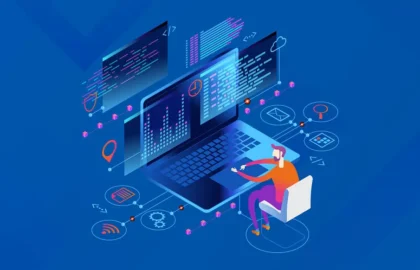
What is Python?
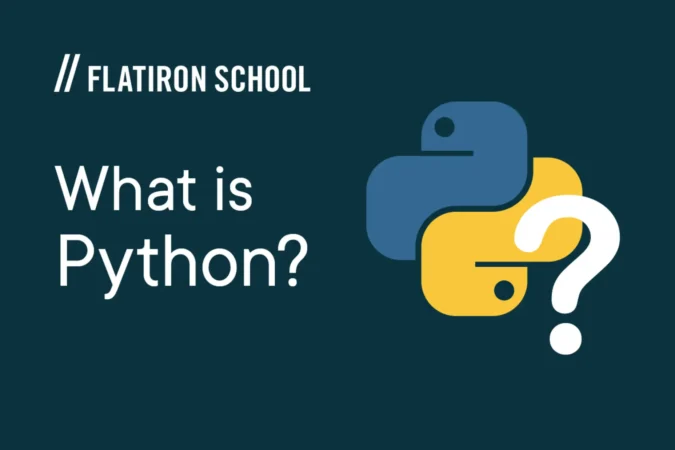
Python is the most popular data science programming language. It’s one of the easiest general-purpose programming languages for beginners to learn, which has many prospective programmers wondering where they can learn Python. Unlike other programming languages, Python can be used for more than just web development or other narrow use-cases.
Often referred to as an object-oriented programming language, when using Python, everything you create is an object. Different objects have different property attributes and different functions, meaning you can operate on various objects in different ways.
Data scientists use Python for a range of tasks like machine learning, deep learning, and artificial intelligence. The versatility of Python, along with the fact that it’s efficient, all contribute to its immense popularity in modern computer science.
What is Python used for?
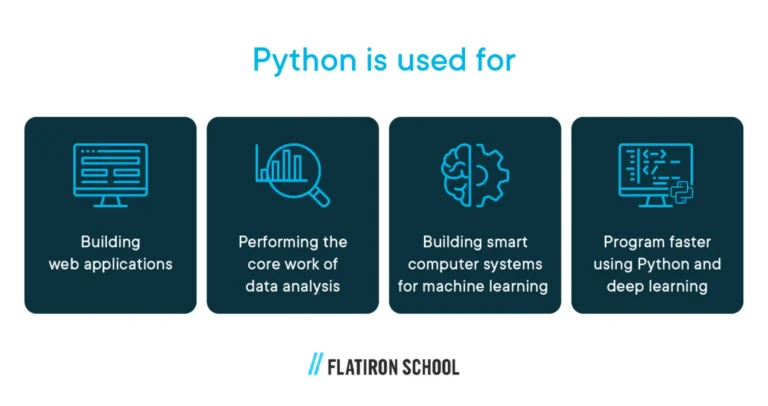
Due to its wide range of uses and the relative ease of learning Python, it’s one of the most popular coding languages. Here’s how Python is used in various applications…
1. Use Python to build web applications that increase efficiency for your business.
Python can be used for a variety of web applications like server-side web applications. It can be used to write the language that runs these applications and to compile data about a website’s traffic. This information can then be used to make decisions about how to maximize conversions and audience engagement.
Other applications include different ways of compiling data and structuring how websites are optimized for user experience.
2. Use Python for the core work of data analysis.
Python supports important tasks in Big Data, which is why it was the most popular data science programming language of 2020. It provides all the tools required for common data science tasks like data collection and cleaning, data aggregation, filtering, and sorting, data modeling, and querying and performing calculations on Big Data using the PySpark library.
Because of how many people know Python, you’ll never be without support when you run into an issue. In addition, you have access to vast libraries of Python code that you can use to increase efficiency in your work.
One example of existing code includes Python’s built-in sort function called list.sort() that can be used to modify the order of data. Another inclusion is Sorted(), which returns the sorted list of old lists. There are many reasons for altering the order that data is sorted in such as changing the order of data to better visualize different aspects of the collected data.
For example, a web developer for a consumer goods website might sort data to determine which items are selling more than others, or what clients are more interested in. This way they can optimize their inventory to sell more of their heavy hitters and increase revenue.
3. Use Python for machine learning to build smart computer systems.
Python is one of the best languages to use for machine learning because the language is understandable to humans, which makes it easier to build models. Python is also compatible with the Jupyter Notebook programming environment, which has “tab completion” meaning it can help “guess” what function a programmer is attempting and do what they want it to do.
The multiple frameworks, libraries, and extensions all contribute to simplifying the implementation of various functionalities. In particular, the scikit-learn library for Python allows developers to work with dozens of different machine learning algorithms using the same model interface. This can help developers build prototypes quickly and test the function of their product’s machine learning capabilities.
4. Use Python and deep learning to program faster.
Deep learning functions similarly to machine learning, however, it can make decisions that resemble the way humans make decisions.
Python is the default language for artificial intelligence due to the large number of advanced deep learning libraries of code that are incredibly useful in AI programming. By using Python libraries such as TensorFlow and PyTorch, developers can cut their programming time down and commence testing much quicker than with other languages.
How to learn Python: Step-by-step instructions to learn Python code
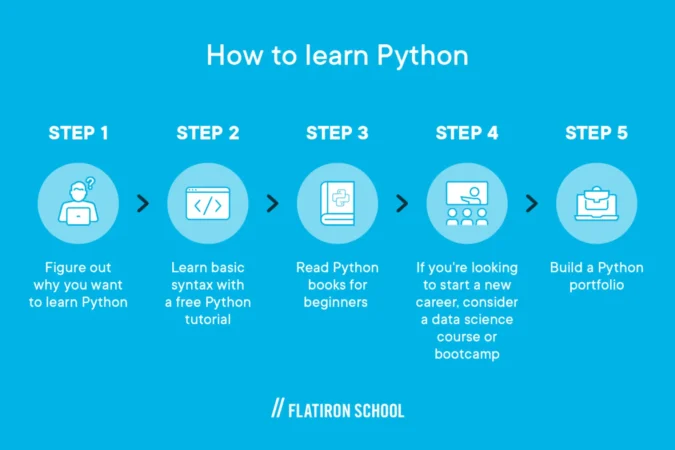
Step 1: Figure out why you want to learn Python
There are many reasons someone might want to learn Python. They may be looking to make a career switch to a tech field, or they’re already in a tech field and want to expand their knowledge to support their current role, or perhaps they’re just curious and want to learn about it.
When beginning to learn Python, it’s important to understand why you want to learn it – what do you hope to get out of it? If the motivation is there and won’t be fleeting, any person with a basic understanding of computers and the functionality of computer programming can learn to code in Python. Without motivation and a clear end goal, boredom can quickly set in, like with many pursuits undertaken on a whim.
Step 2: Learn basic syntax with a free Python tutorial
There are many resources available for learning Python syntax, which is the first step towards understanding the language. Without learning the syntax, you’re not going anywhere.
Fortunately, there are many options available from simply reading web pages, to free workshops and lessons.
If you want a guided learning experience, such as with a Python video tutorial, Flatiron School offers a workshop to learn Python for free that’s a great place for beginners to start.
If you’re into reading and teaching yourself, check out this free interactive Python tutorial from learnpython.org.
Step 3: Read Python books for beginners
Reference books are another good place to start, and helpful to have on hand throughout your time coding Python. They teach the philosophy behind Python as well as the utility. Some great examples include:
- Python Crash Course, 2nd Edition
- Learn Python 3 the Hard Way
- Head First Python, 2nd Edition
- Think Python: How to Think Like a Computer Scientist
Step 4: If you’re looking to start a new career, consider a data science course or bootcamp
If your end-goal of learning Python is to begin a new career, a data science course — often called a data science boot camp when taken outside of a university setting — will be very helpful to ensure you’re adequately prepared to use Python professionally.
Bootcamps
Pros of attending a data science bootcamp
A data science coding boot camp is one of the fastest ways to learn practical coding skills. It will be rigorous, with a heavy workload, but the idea is that by the end of it you’ll be closer to stepping into a professional data science career.
Accessibility to traditional computer science degrees from a university is a big reason why coding boot camps are so popular. You don’t need a technical background to be accepted to a bootcamp.
Practical skills are what boot camps focus on instilling in students. A four-year computer science program at a university emphasizes more theory in their curriculum, along with teaching various other programming languages. For someone that knows what language they want to take and are doing it to gain practical skills, a data science bootcamp can be the perfect option.
Cons of attending a data science bootcamp
There is no national accreditation, which means a certificate of completion for a boot camp is not the same as a college degree.
It is not as in-depth as a traditional data science 4-year program. There’s a lot of theory that you simply won’t get in a boot camp, which is more focused on teaching practical skills that can be used in today’s job market – there isn’t a lot of time spent on the “why” or “how” behind every skill that is taught. Students tend to specialize and research topics that they are particularly interested in on their own..
They can be expensive, and financial assistance that college students may be eligible for may not be as significant for people seeking help to pay for a coding boot camp.
Step 5: Build a Python portfolio
Once you’ve got the basics under your belt and are actively coding and building, keep at it. The only way to ensure you continue to grow and excel as a Python programmer is to continually challenge yourself. Try harder projects with larger scopes, and add everything to your portfolio. Think of it as a record of your accomplishments that keeps growing and becoming more impressive.
Other applications include different ways of compiling data and structuring how websites are optimized for user experience.
Can I learn Python on my own?
Pros of self-teaching Python
If you choose to self-teach yourself Python, there are a few advantages. First, there’s a wealth of informational resources available for free on the internet. Secondly, it’s an efficient way to learn if you aren’t yet ready to invest financially.
Cons of self-teaching Python
When teaching yourself anything, your biggest hurdle will be not having an instructor to field your questions or lead you in the right direction. Fortunately, there’s a lot of options out there like Flatiron School’s free Python lesson.
Is learning Python enough to get a job?
Simply knowing how to code Python may be enough to get a job, but generally speaking, employers looking for a tech person will be looking for a set of skills, rather than just a Python coder. You’ll likely be hard pressed to find a job listing that is entirely about Python. You’ll need to learn more programming languages.
One of the positives of taking a data science boot camp is that, while it won’t give you every skill you’ll need to succeed in an IT role, it should help you get a good picture of the skills you’ll need to land a tech position.
What jobs can I get with Python?
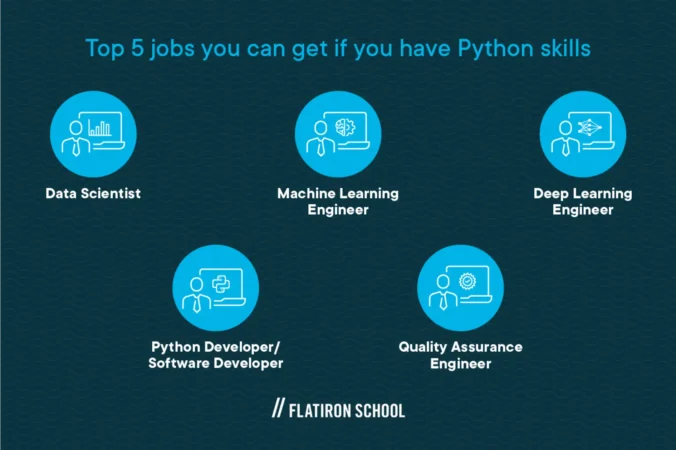
Top 5 jobs you can get if you have Python skills:
1. Data scientist: Mine and analyze data to drive optimization, develop data models, develop processes and tools to monitor and analyze model performance and data accuracy
2. Machine learning engineer: Design self-running software to give machines the ability to automate predictive models, work with data scientists to feed curated data into models, use theoretical models, improve programming frameworks
3. Deep learning engineer: Similar in job scope to a machine learning engineer, deep learning engineers tend to work more directly with developing artificial intelligence
4. Python developer/software developer: Design and implement software, analyze and test programs, seek ways to improve software processes and interactions
5. Quality assurance engineer: Create tests to identify issues with software before launch, analyze bugs and errors to document for review, report results of tests
Curious if this course is right for you?
Learn more about Python
Frequently Asked Questions
Learning a programming language on your own does run the risk of piecing together different resources to get a complete coding education. By using interactive coding lessons, you can learn the Python Basics or get more advanced with Python.
Check out these free Python lessons from Flatiron School:
You can also learn more about Python in the following articles:
Yes, you can learn Python in a month, but it won’t be easy. If you already know other programming languages, it’s an achievable goal to be able to code simple to mid-difficulty Python processes in a month or so. For those unfamiliar with coding, several months of practice and learning will be necessary to start building your own projects with Python.
Keep in mind that it will take consistent effort to become a Python expert, and experts continue learning long after they’ve landed their first job.
There are a ton of different ways to practice Python online. Try some of these from Dataquest.
Python is widely considered one of the easiest programming languages to learn, with many universities teaching their students Python before other coding languages. All someone needs to learn is the desire to start and the motivation to see it through. After that, just keep coding!
Like learning any programming language, Python can be challenging. Giving instructions to a computer involves adjusting your thinking to be more precise, as well as learning to notice small differences in punctuation such as { vs [.
The good news is that it’s one of the easiest languages to learn. By following the step-by-step approach outlined below, the frustrating moments of “where do I start?” and “what do I do next?” will be minimized and you’ll be on your way to coding Python.
When learning a new programming language, it’s generally a better idea to go with the newest version. Python 2 is still being used by some professionals, but it’s now outdated and no longer officially supported (meaning there will be no future bug fixes). You will likely want to use the newer, more in-demand Python 3, which also includes a typing system that Python 2 doesn’t have.




